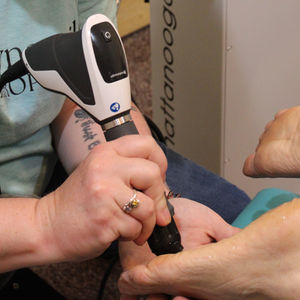Shockwave Therapy
Shockwave therapy was first introduced over 20 years ago as a method for treating kidney stones. One of the side effects discovered during treatment, was the effect on bone healing (bone density increase), as well as accelerated tissue healing in the area.
When we talk about shockwave treatment there are basically two different methods:
Focused Shockwave- Can be electromagnetically generated, high energy, deep penetration, and precise focus on a very small area.
Radial Shockwave- Radial shockwaves are often referred to as Radial Pressure Waves or RPW. In physical terms this is the correct definition. This method is less energy and focuses on a more broader area of treatment at a time and not as deeply penetrating.
How are the Pressure Waves Generated?
Radial pressure waves are generated by compressed air. The compressed air is used to drive a projectile in a cylinder, located inside the hand piece of the machine, to a shock transmitter. The kinetic energy generated by the motion and weight of the projectile, converts into acoustic energy when the projectile hits the shock transmitter. the acoustic pulses then spread into the underlying tissue, treating a larger area than the focused shockwave method.
Radial Pressure Waves offer a non invasive treatment solution to long term insertion and soft tissue pathologies. Local treatment in the affected area will support and reset the healing pattern.
Some of the benefits can include:
-
Pain Reduction- The patient experiences a reduction of pain, explained by the Gate Control Theory. Intensive pulses from the transmitter into the tissues create a strong nociceptor activation of the A-B fibers, which affect interneurons that inhibit the transmission of the pain signals.
-
Increased Metabolism- Shockwaves influence the tissues on a cellular level. The chemical environment of the cells is affected by free radicals promoting the release of pain and inflammatory inhibiting substances.
-
Revascularization- Repeated shockwaves to the affected area create a revascularization effect, with the new blood flow in the area promoting the tissue healing and regeneration.
-
Reduced muscle tone- The "vicious circle", as well as the strong pathological association between pain and muscle tone, will be broken and lead to restoring a normalized muscular tone.
What can be Treated?
Soft tissue, connective tissue, muscles with trigger points, increased tension areas, and insertional tendinopathies. Some examples are:
-
Plantar Fasciitis
-
Achilles Tendon Pain
-
Shin Splint
-
Muscle Sprain
-
Jumpers/Runners Knee
-
Tigger Point Therapy
-
Trochanteric Insertion Tendonitis
-
Piriformis Syndrome
-
Low Back and Thoracic Pain
-
Calcified Shoulder Tendonitis
-
Frozen Shoulder
-
Cervicobrachial Neuralgia
-
Trapezius Tension
-
Radial/Medial Epicondylitis
-
Finger Tendonitis
-
Muscular Cramps/Spasms
How Many Treatments Will I Need?
This will depend on each persons unique situation and ailment. Our doctor will go over the treatment options that are right for you. Normally for chronic conditions, a single area will take anywhere from 8-12 sessions with less chronic issues typically taking 4-8 sessions. Each session is done once per week with each session taking about 10-20 minutes. Most patients feel results right away and report increased mobility.
Each patient that comes in will get a customized treatment plan catered around their specific ailment and need.

Shockwave Gallery








